The NYPD Is Back to Its Violent Old Ways
New York City police promised to minimize their presence at protests and stop brutalizing demonstrators. The NYPD is barely pretending to follow the settlement agreement.
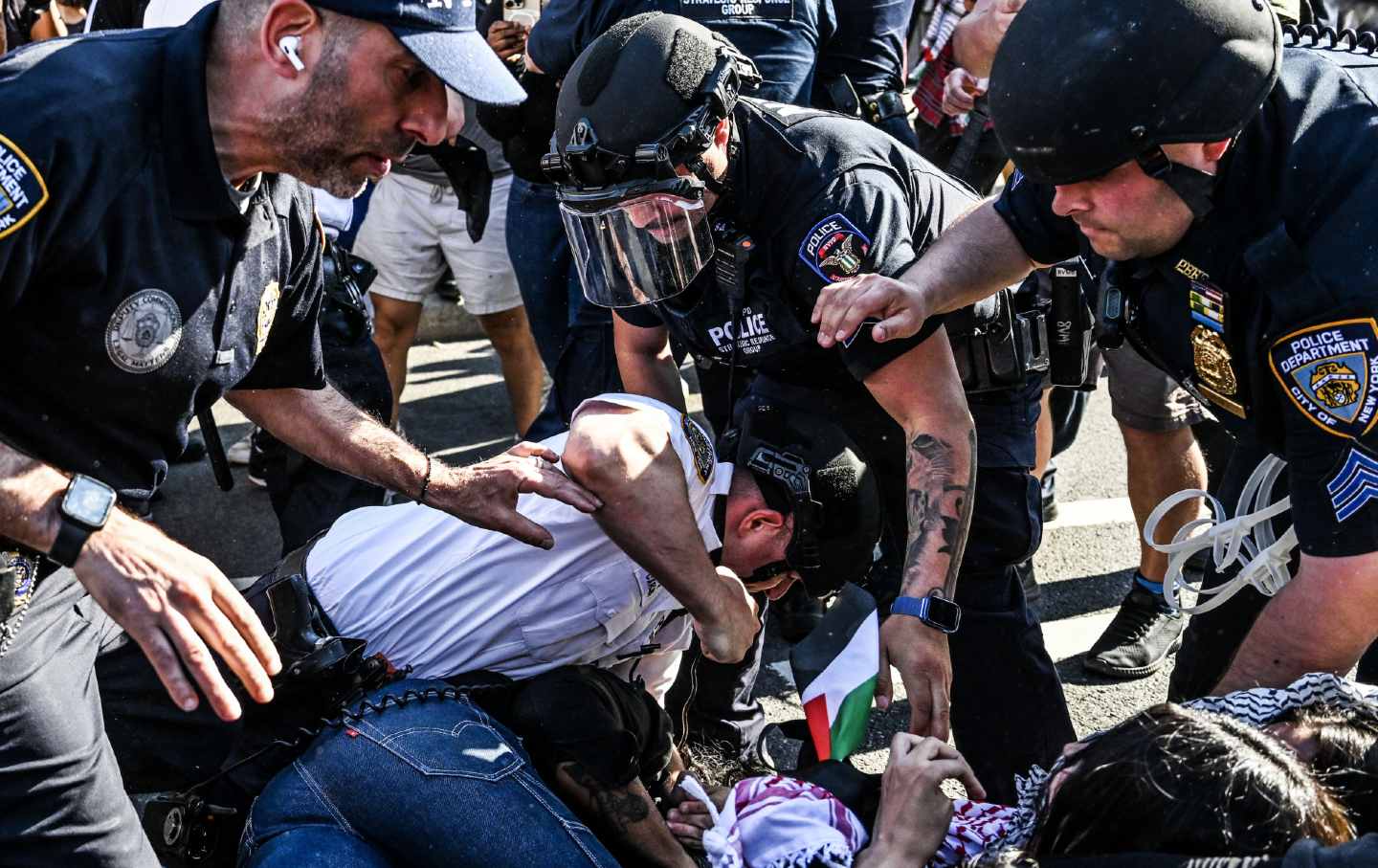
New York City police arrest protesters in Brooklyn on May 31 during a demonstration against Israeli attacks on Rafah. On February 5, a New York court approved a settlement agreement that obligates the NYPD to minimize its presence at protests and facilitate First Amendment activity.
(Fatih Aktas / Anadolu via Getty Images)
Isabelle Leyva has been monitoring protests for the New York Civil Liberties Union (NYCLU) since summer 2020, when police in New York City routinely trapped and assaulted medics, legal observers, and peaceful protesters. On May 29, 2020, at a protest outside Brooklyn’s Barclays Center, Leyva watched police in riot gear beat demonstrators with batons and arrest dozens. For the rest of the summer, she spent almost every day at protests, as a monitor and participant, where she was pepper-sprayed, beaten, and trapped by police. But Leyva had still never seen a police response of the scale of the NYPD’s April 30 raid of Columbia University’s student encampment. “It looked like an army that descended onto Broadway and Amsterdam to shove protesters into barricades so that they could not access campus,” she told me. “It was like a scene from some kind of war film.”
Hundreds of police cleared people from the streets surrounding campus, creating what Leyva described as a militarized “shutdown arrest zone” between 114th and 120th streets. NYPD Chief of Department Jeffrey Maddrey later testified to the City Council Committee on Public Safety that between 600 and 700 cops were deployed to Columbia that night. “I believe we did a very safe procedure,” he said. During the raid, police pepper-sprayed, threw to the ground, and drew weapons on students, resulting in multiple injuries, according to reports received by the NYCLU. An officer also fired a gun inside the university’s occupied Hamilton Hall.
Just a few months before the Columbia raid, on February 5, 2024, a District Court approved a settlement between the NYPD and New York Attorney General Letitia James, the Legal Aid Society, and the New York Civil Liberties Union (NYCLU). The lawsuit alleged that the police brutalized protesters during the summer of 2020, arresting protesters, journalists, and legal observers in retaliation for their speech. The rollout of the agreement, which requires the NYPD to revamp its tactics to minimize police presence at protests and facilitate First Amendment activity, has coincided with the largest protest movement the city has seen since 2020. As the administration of Mayor Eric Adams and right-wing city councilmembers call on the NYPD to break up pro-Palestinian demonstrations, legal observers and protest organizers say police are already engaging in banned practices. “They’re trying to normalize bringing back police on a greater level,” said Nerdeen Kiswani, cofounder of the Palestinian-led organization Within Our Lifetime.
A key tenet of the settlement agreement is a tiered response to protests. At the beginning of marches and rallies, the police presence is supposed to be kept to a minimum. Such demonstrations should be labeled as “tier 1,” meaning that only community-affairs officers will be dispatched. The number of officers deployed and the nature of the police response can increase if officers believe that illegal activity is about to occur, is already occurring, or has become so widespread that “targeted enforcement has not worked and cannot work.”
Settlement implementation is currently in its first phase, during which the NYPD has time to reform its policies and training. There is no set deadline by which the NYPD has to generate these new policies, and it has yet to produce draft procedures. In the second phase of settlement implementation, which will last for no longer than three years, a monitoring committee made up of representatives from the state attorney general’s office, the NYCLU, the Legal Aid Society, the city’s corporate counsel, the commissioner of the Department of Investigation, and the police will meet regularly to ensure compliance with the new policy. In phase three, which lasts for just a year, if the NYPD violates the terms of the agreement, plaintiffs in the suit can reopen the matter in court. In the meantime, JP Perry, a senior attorney with the NYCLU, said, “they have to not be doing things that really fly in the face of the spirit of the agreement.”
Mayor Adams lauded the settlement when it was announced in September 2023, saying the new practices would “better address the unique challenges that rise during spontaneous protests, keep New Yorkers safe, and respect every person’s First Amendment rights to free speech.” But when confronted with the protests over Israel’s war in Gaza, Adams’s enthusiasm dimmed. At a December 2023 press conference, the mayor said, “The decision that came out of this agreement, I thought it put us in a very troubling direction. And now you’re seeing it. You see 1,000 people go to Grand Central station, deciding they want to just close down Grand Central station or they want to sit on the street in front of Times Square.”
Months later, Adams appeared to encourage police to disregard the legally required tiered approach. When asked at a press conference about the NYPD’s response to a pro-Palestinian protest in Bay Ridge on May 18, videos from which showed police punching, pushing, and roughly handling protesters, Adams replied, “When you cross over that line, there’s no tier to that. I’m not going to tell police officers, you need to wait until six people spit in your face before you take action.” (Kiswani told The City that the NYPD started arresting protesters almost immediately at the march.)
The Police Benevolent Association (PBA), the union representing NYPD officers, has echoed the mayor’s arguments citing the pro-Palestine protests to fight the settlement agreement. In a November 2023 memo as part of a legal action seeking to block the settlement, the PBA wrote, “How would police have coped with the recent, chaotic demonstrations relating to the events in Israel and Gaza, if no officers (other than community liaisons) could show their faces until crimes were actually committed?” The protests since October 7 have been largely peaceful, according to the NYCLU, and Leyva said a large police presence armed with militarized equipment itself escalates tensions. “It very quickly devolves into chaos if and when the police do use the forces that they have there,” she said.
Conservative city councilmembers have also urged the NYPD to crack down on demonstrators. On January 18, NYPD Chief of Patrol John Chell met with the City Council Common Sense Caucus, a conservative-leaning coalition. Caucus member Councilwoman Vickie Paladino said on X that the purpose of the meeting was to discuss “the ongoing pro-Palestinian protests, quality of life, crime in the city, and how these issues are being handled.” (Paladino has also called Within Our Lifetime’s Kiswani a “terrorist leader.”) After Columbia announced the cancellation of its graduation ceremony, another member of the Common Sense Caucus, Councilwoman Inna Vernikov, said on X, “This is what happens when we let snot-nosed brats run rampant and play revolutionary.”
Maddrey, the NYPD chief of department, testified at a March 20 City Council Public Safety Committee meeting that the NYPD tries to start with “the lightest touch possible” when policing protests. “When the protest starts, we try to start with the fewest number of officers possible,” he said. But over the last several months, the NYCLU has observed what it called in a statement “massive deployments” of NYPD officers to rallies. “The deployments are remarkable—there are police everywhere—on foot, on bikes, in vehicles. Many police are present before the protests even begin.”
Recently there have often been more officers than protesters at demonstrations. At an April 2 protest outside an Israeli real-estate event, NYCLU protest monitors said that NYPD personnel outnumbered the crowd of fewer than 30 protesters. During a March 8 pro-Palestinian protest, Leyva said on X that protesters were outnumbered by police for much of the event. To break up the student encampment at NYU on May 6, the NYPD deployed an “incredible amount of police for a very small encampment and very small protest outside.”
The NYCLU has raised particular concerns about discrepancies in the size of deployments at the outset of actions organized by Palestinian, Arab, and Muslim-led groups, including Within Our Lifetime. Perry told me, “We’re seeing a one-sided approach targeting people for a specific message.”
Popular
“swipe left below to view more authors”Swipe →Police response to recent protests has often included officers from the Strategic Response Group (SRG), a unit founded in 2015 to focus on counterterrorism and political protests. After community pushback over the conflation of these two policing objectives, then–Chief of Department James O’Neill promised that the group would engage only in counterterrorism operations. But just months later, the SRG was deployed to a protest over the police killing of Freddie Gray. The description of the SRG on the NYC website no longer mentions counterterrorism at all: The SRG “responds to citywide mobilizations, civil disorders, and major events with highly trained personnel and specialized equipment.”
According to the settlement agreement, the SRG can be deployed only in “tier 3” protest scenarios, when officers have identified probable cause for arrest. At a City Council Public Safety Committee meeting on March 20, Deputy Commissioner of Legal Matters Michael Gerber said that according to current NYPD policy, “In most protests in the city, SRG is not there and nowhere to be found and not even close.” But later in that same hearing, NYPD Chief of Special Operations Wilson Aramboles testified that the SRG had been deployed 205 times to protests in the previous three months.
In recent weeks, SRG officers have been deployed to a pro-Palestinian protest outside of the Met Gala and to break up student encampments at Columbia, NYU, and City College of New York (CCNY). “When the SRG is there, the NYPD is quicker to escalate because they have the resources there,” said Leyva, “They’re trained in military tactics and then sent to protests.” According to the NYCLU, police indiscriminately used pepper spray against protesters and a legal observer at NYU on April 22, and shoved protesters with batons at CCNY. At the May 18 Bay Ridge protest, monitors witnessed “aggressive escalation” by SRG officers, and violent arrests of protesters and members of the press.
Under the terms of the settlement, police must not use the crowd-control tactic of “kettling” protesters, which involves surrounding, trapping, and arresting protesters without providing an opportunity for them to disperse.
According to Leyva, during a pro-Palestinian protest on Wall Street in February, SRG cops blocked both sides of a small street in order to arrest protesters. At an earlier protest on October 21 in Bay Ridge, NYCLU protest monitors reported that they were trapped and blocked from leaving by police. Though she declined to comment on specific instances, Perry said, “The use of kettling as a crowd control tactic without giving people notice that they should disperse or leave before arrests are happening and encircling protesters without any basis for arresting them is definitely prohibited by the settlement.”
The settlement also requires officers to “accommodate” demonstrations on public streets whenever possible, but many of the arrests in recent months have been for blocking roadways and the use of sound devices, which suggests the strictest possible interpretation of current laws. At a May 11 demonstration at Barclays Center commemorating the 76th year of the mass expulsion of Palestinians, police arrested protesters as soon as the march stepped off for blocking the roadway and for using sound devices. At a March 23 pro-choice rally in Foley Square, Leyva said, police arrested protesters for using drums.
Police often arrest protest leaders who use megaphones to communicate messages to the crowd, including from police. According to Kiswani, “In the last 10 years of organizing massive marches and protests and rallies for Palestine across the city, we have never had to get a sound permit, which is something that is suddenly being enforced now and used as an excuse to brutalize and arrest protesters, including organizers.”
NYPD Chief of Patrol Chell has spelled out these tactics explicitly, posting on X in February, “I am top brass and you better believe my directive is to crackdown [sic] on devices, roadways, and anything else to enforce the law!”
Perry told me that these kinds of statements “leave the impression that the NYPD is more interested in enforcement and cracking down and taking a tough-on-crime approach when what they’ve agreed to in the settlement is to protect and facilitate First Amendment activity” She added, “Police should stop focusing on making these kinds of inflammatory statements and refocus on enforcing the terms of the settlement.”
We cannot back down
We now confront a second Trump presidency.
There’s not a moment to lose. We must harness our fears, our grief, and yes, our anger, to resist the dangerous policies Donald Trump will unleash on our country. We rededicate ourselves to our role as journalists and writers of principle and conscience.
Today, we also steel ourselves for the fight ahead. It will demand a fearless spirit, an informed mind, wise analysis, and humane resistance. We face the enactment of Project 2025, a far-right supreme court, political authoritarianism, increasing inequality and record homelessness, a looming climate crisis, and conflicts abroad. The Nation will expose and propose, nurture investigative reporting, and stand together as a community to keep hope and possibility alive. The Nation’s work will continue—as it has in good and not-so-good times—to develop alternative ideas and visions, to deepen our mission of truth-telling and deep reporting, and to further solidarity in a nation divided.
Armed with a remarkable 160 years of bold, independent journalism, our mandate today remains the same as when abolitionists first founded The Nation—to uphold the principles of democracy and freedom, serve as a beacon through the darkest days of resistance, and to envision and struggle for a brighter future.
The day is dark, the forces arrayed are tenacious, but as the late Nation editorial board member Toni Morrison wrote “No! This is precisely the time when artists go to work. There is no time for despair, no place for self-pity, no need for silence, no room for fear. We speak, we write, we do language. That is how civilizations heal.”
I urge you to stand with The Nation and donate today.
Onwards,
Katrina vanden Heuvel
Editorial Director and Publisher, The Nation
More from The Nation
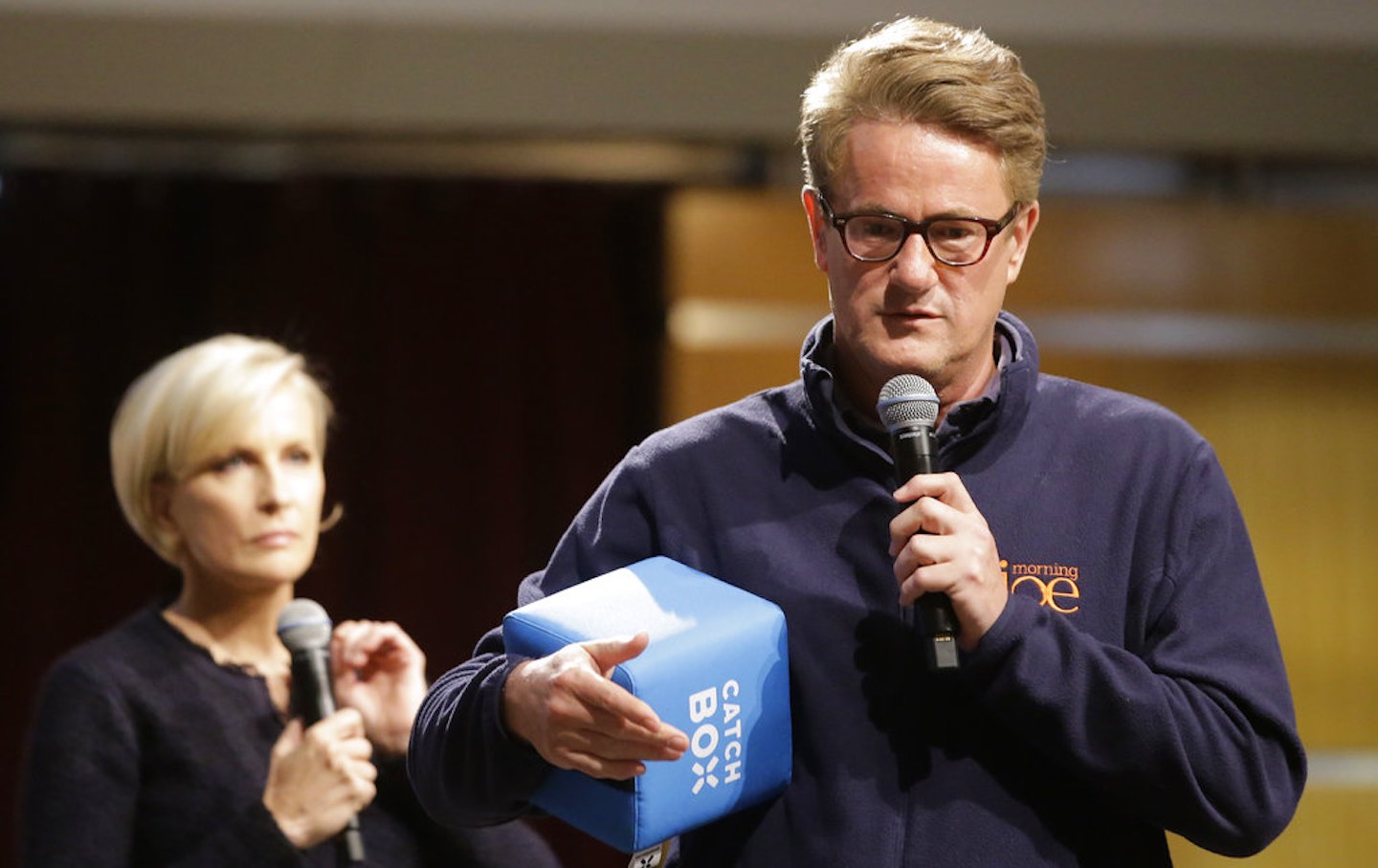
Mr. Scarborough Goes to Mar-a-Lago Mr. Scarborough Goes to Mar-a-Lago
The hosts of Joe Biden’s favorite political talk show have quickly pivoted to kissing the ring of the incoming president.

Watching a Parallel Media Try to Make Trump the Big Sports Story Watching a Parallel Media Try to Make Trump the Big Sports Story
The president-elect did not dominate the world of sports this weekend, but Fox News and Internet tabloids are inventing new realities.
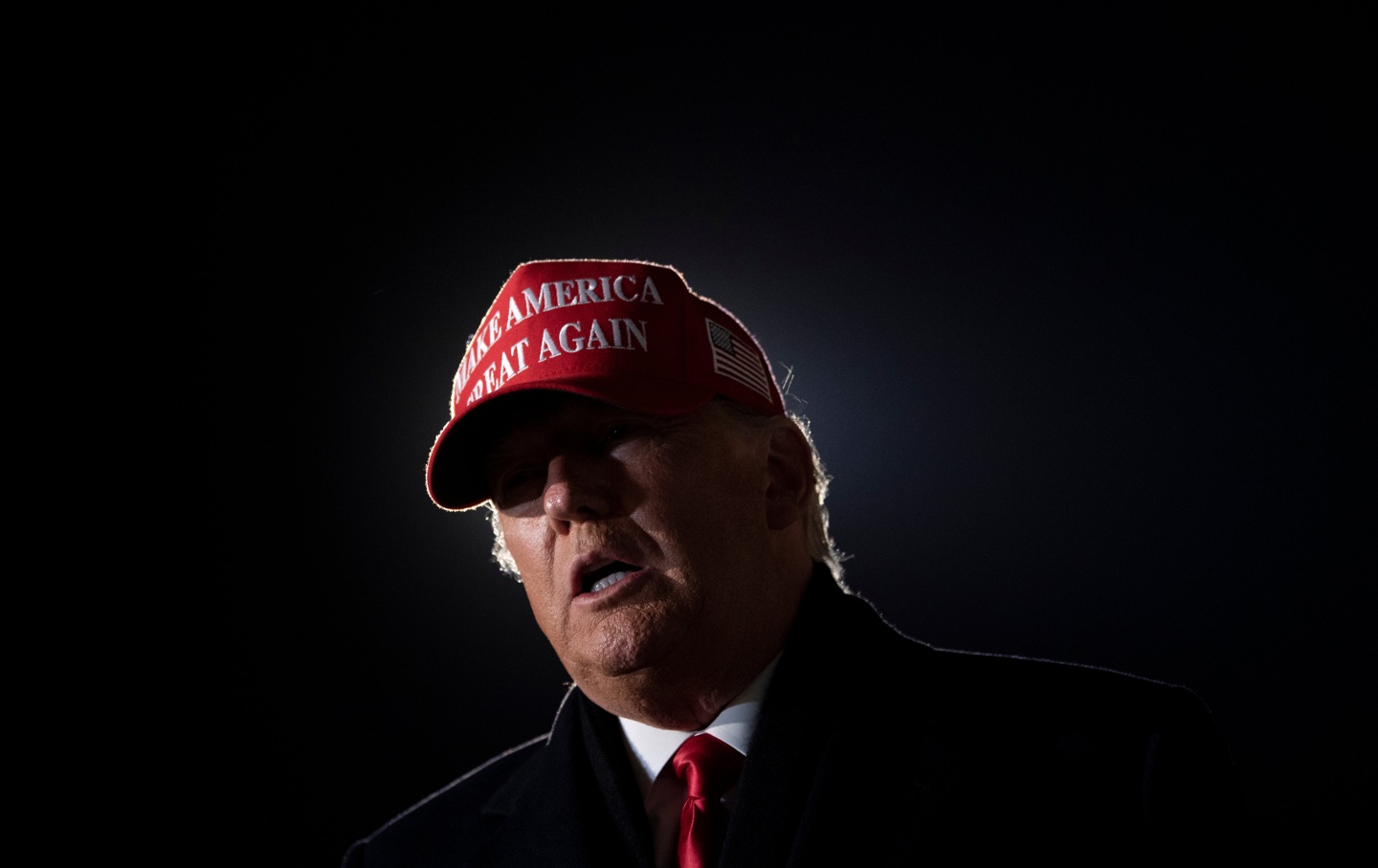
The First Amendment Will Suffer Under Trump The First Amendment Will Suffer Under Trump
Given what’s heading our way, we need a capacious view and robust defense of the First Amendment from all quarters.
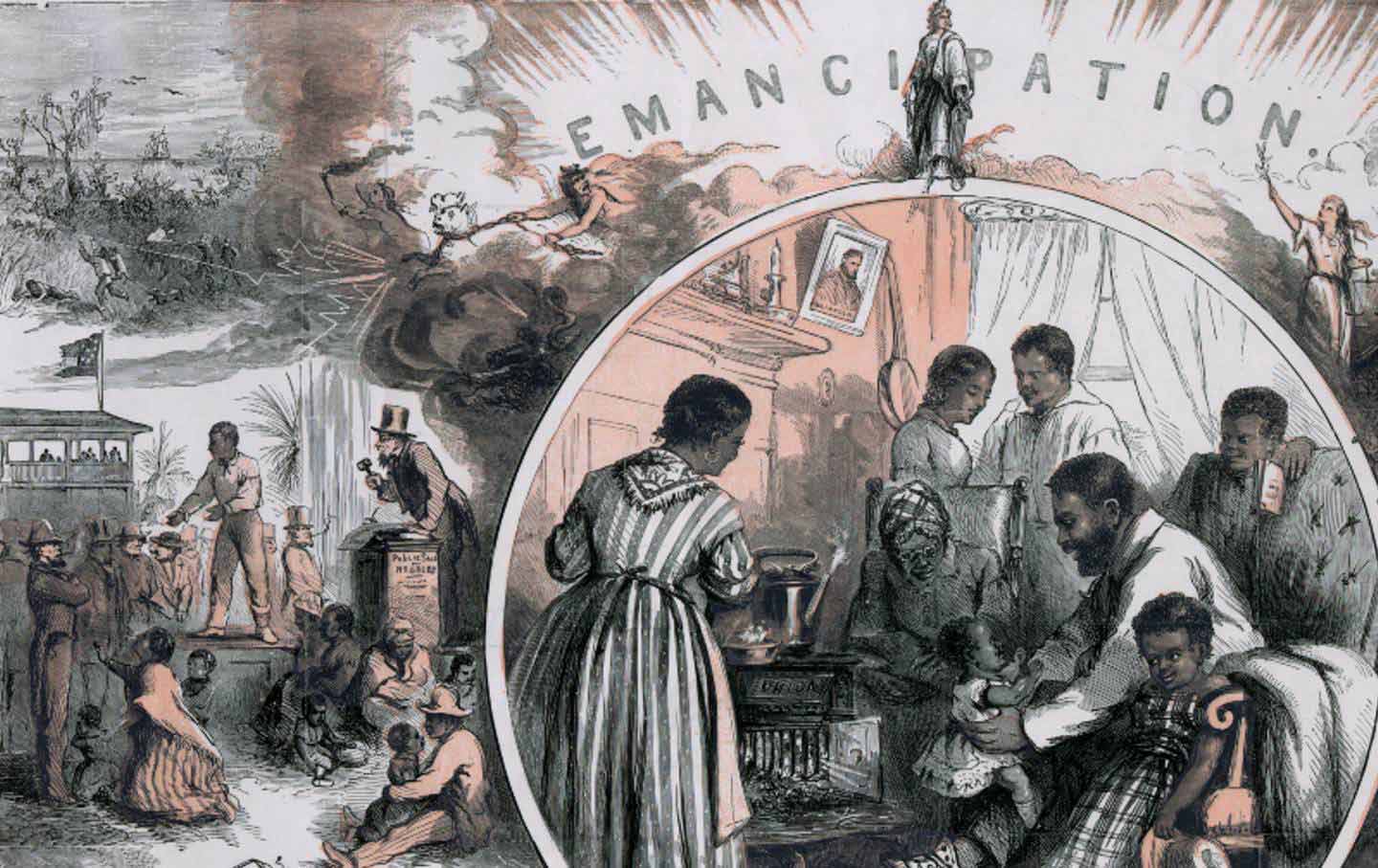
Slavery in an Age of Emancipation Slavery in an Age of Emancipation
Robin Blackburn’s sweeping history of slavery and freedom in the 19th century.

How Wisconsin Lost Control of the Strange Disease Killing Its Deer How Wisconsin Lost Control of the Strange Disease Killing Its Deer
Despite early containment efforts, chronic wasting disease has been allowed to run rampant in the state. That’s bad news for all of us.
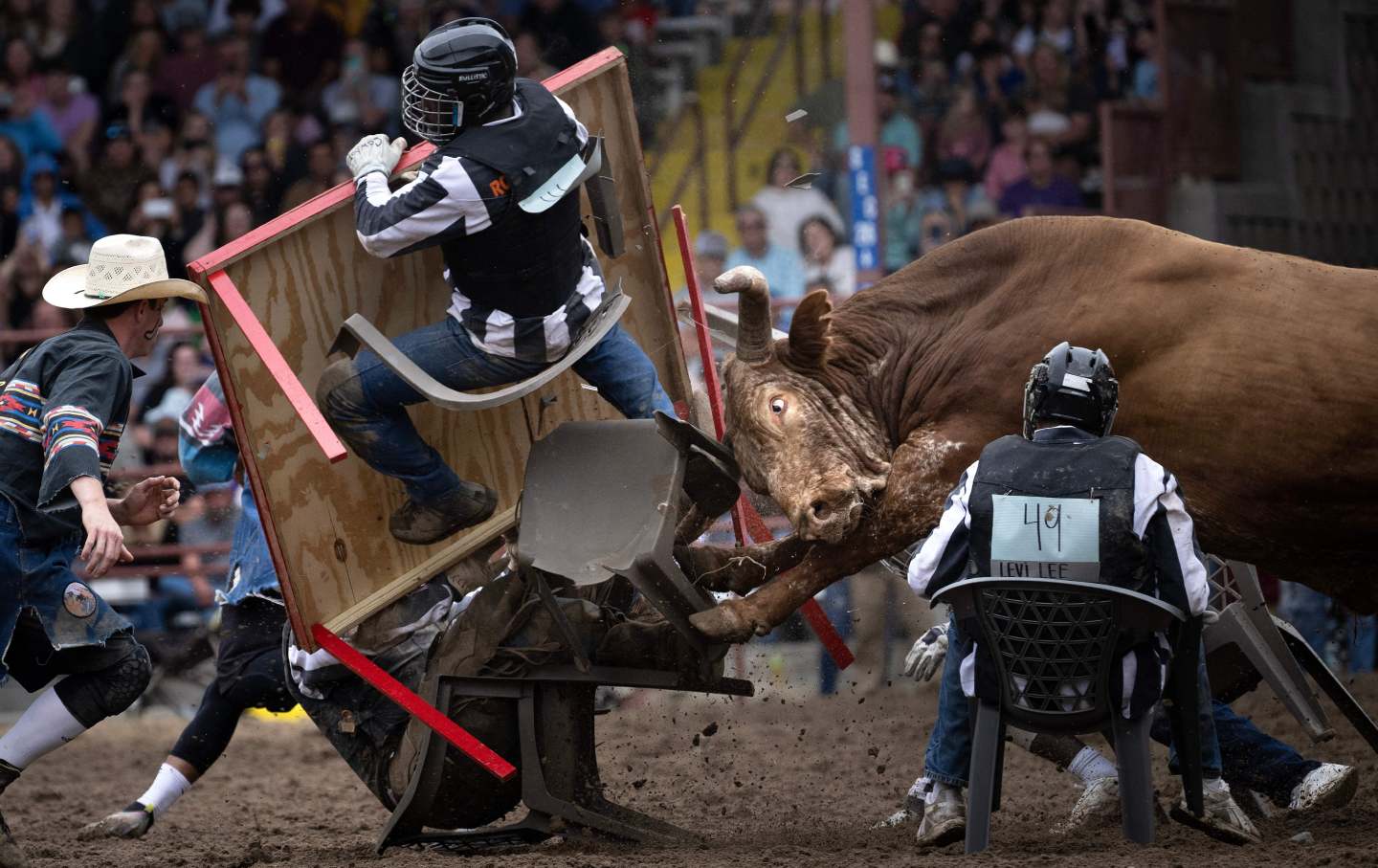
The Prison Rodeo at the Heart of Legal Enslavement The Prison Rodeo at the Heart of Legal Enslavement
Angola prison workers make between 2 and 40 cents an hour. They also have a controversial outlet for recreation and to vend their wares at market rate: a rodeo.


